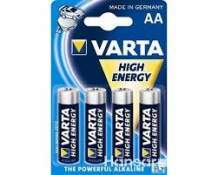Types of batteries

What type of battery should you choose?
There are different types of batteries on the market today: different sizes, different technologies, different voltages, rechargeable and disposable. So how do you know which one to use? This article provides some basic facts about the different types of batteries available.
Glossary
Element
A device that produces voltage through a chemical reaction and can supply current to power electronic or electrical devices, appliances or tools. Examples include AA, AAA, C and D cells. Although they are technically called "cells", they are still commonly referred to as "batteries".
Battery
A single cell can only produce a low voltage, usually 1.2, 1.5, or 3.6 volts. Batteries are made up of multiple cells connected in series so that the voltages add up. For example, a 9-volt PP3 (MN1604) battery consists of six flat cells stacked on top of each other to produce 6 x 1.5 = 9 volts. The cells are encapsulated in an outer shell. A lead-acid car battery is made up of 6 cells in series to produce 12 volts.
Non-rechargeable batteries
They are disposed of when they run out of power and the energy they store has been used up.
Rechargeable batteries
They can be recharged with a charger designed for batteries and used again and again.
Capacity
The capacity of the battery. It is measured in milliampere-hours (mAh) or ampere-hours (Ah). The higher the capacity, the longer the battery will last.
Non-rechargeable batteries (primary cells)
Non-rechargeable or primary cells are available in all standard sizes and voltages: AA, AAA, C, D and PP3 (MN1604). The nominal voltage of the cells is 1.5 volts and 9 volts for the small square PP3 type.
There are several widely available battery/cell technologies:
Zinc carbon battery. These were the first widely available non-rechargeable cells and are generally the least expensive. They have a capacity of one-quarter to one-fifth that of alkaline cells. They have a relatively high internal resistance, making them more suitable for low-current drain devices such as radios, toys and low-power flashlights. They do not perform well at low temperatures, and high temperatures can dry out the electrolyte.
Zinc Chloride Battery. These are improvements on zinc carbon, with 50% more capacity than zinc-carbon, higher current capacity, and better leak resistance. They also have better low-temperature performance and longer shelf life.
Zinc-carbon or Zinc Chloride?
The "Super Heavy Duty" designation on a battery refers to zinc chloride rather than zinc-carbon.
Chemically, zinc chloride uses cleaner materials, which makes it slightly more expensive to manufacture and more durable than zinc-carbon batteries.
If the cheapest batteries in the store are not listed, they are probably zinc-carbon batteries.
Alkaline battery. These are 6 times better than the average zinc-carbon battery. They have several advantages over zinc batteries. They have three to five times the capacity, can deliver high current, have good high and low temperature performance, and have a long shelf life, losing about 5% of their capacity per year. Alkaline batteries are the most expensive compared to zinc cells, but the price difference has decreased over the past 20 years as production has increased. Alkaline cell capacity is highly dependent on the current load. At low current, an AA cell can have a capacity of 3AH, but at a current of about 1 amp, it can drop below 1AH (which is typical for high-power gadgets).
Lithium. Lithium batteries last longer than alkaline batteries – they produce twice the voltage, have a lifespan of up to four times longer and are much lighter than alkaline batteries. They also work very well in extreme temperatures – hot or cold. Voltages range from 1.8 to 3.7 volts. Batteries are expensive compared to alkaline cells (alkaline), but they have a higher energy storage density. They are suitable for applications with high current requirements and the output voltage is constant during discharge, unlike the slope voltage of other primary cells. Lithium cells have a very long shelf life and only lose capacity by about 0.5% per year. There are several types:
- 3-volt lithium cells in the CRV3 format, which is like two AA cells side by side. This allows them to be used as replacements in devices that take two or four AA cells side by side. 3-volt CR123A cells are often used to power digital cameras and wireless sensors in security alarm systems.
- AA-sized lithium iron disulfide cells. These cells have an open circuit voltage of about 1.8 volts, which drops to about 1.7 volts when almost empty. They have a shelf life of about 20 years. 3-volt lithium coin cells are commonly used to power watches.

 The data shown here, especially the complete database of car spare parts, may not be copied. It is strictly prohibited to duplicate the data and database and distribute the same, and/or instruct third parties to engage in such activities, without prior consent from TecAlliance. Any use of content in a manner not expressly authorized constitutes copyright infringement and violators will be prosecuted.
The data shown here, especially the complete database of car spare parts, may not be copied. It is strictly prohibited to duplicate the data and database and distribute the same, and/or instruct third parties to engage in such activities, without prior consent from TecAlliance. Any use of content in a manner not expressly authorized constitutes copyright infringement and violators will be prosecuted.